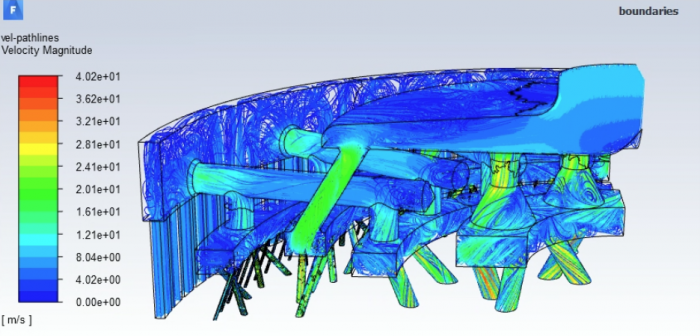
The Michigan Aeronautical Science Association (MASA) is a student-run engineering team at U-M that has been designing, building, and launching rockets since its inception in 2003. Since late 2017, MASA has focused on developing liquid-bipropellant rockets—which are rockets that react to a liquid fuel with a liquid oxidizer to produce thrust—in an effort to remain at the forefront of collegiate rocketry. The team is made up of roughly 70 active members including both undergraduate and graduate students who participate year-round.
Since 2018, MASA has been working on the Tangerine Space Machine (TSM) rocket which aims to be the first student-built liquid-bipropellant rocket to ever be launched to space. When completed, the rocket’s all-metal airframe will stand over 25 feet tall. The TSM will reach an altitude of 400,000 feet and will fly to space at over five times the speed of sound.
MASA is building this rocket as part of the Base 11 Space Challenge which was organized by the Base 11 Organization to encourage high school and college students to get involved in STEM fields. The competition has a prize of $1 million, to be awarded to the first team to successfully reach space. MASA is currently leading the competition, having won Phase 1 of the challenge in 2019 with the most promising preliminary rocket design.
Since the start of the TSM project, MASA has made great strides towards achieving its goals. The team has built and tested many parts of the complete system, including custom tanks, electronics, and ground support equipment. In 2020, the experimental rocket engine designed by MASA for the rocket broke the student thrust record when it was tested, validating the work that the team had put into the test.
The team’s rapid progress was made possible in-part by the extensive and lightning-quick simulations using the ARC-TS Great Lakes High-Performance Computing Cluster.
The student engineers are Edward Tang, Tommy Woodbury, and Theo Rulko, and they have been part of MASA for over two years.
Tang is MASA’s aerodynamics and recovery lead and a junior studying aerospace engineering with a minor in computer science. His team is working to develop advanced in-house flight simulation software to predict how the rocket will behave during its trip to space.
“The previous computer we used would take as long as six hours to render simulations. It takes 15 minutes on Great Lakes.”
-Edward Tang
“Working on the Great Lakes HPC Cluster allows us to do simulations that we can’t do anywhere else. The simulations are complicated and can be difficult to run. We have to check it, and do it again; over and over and over,” said Tang. “The previous computer we used would take as long as six hours to render simulations. It took 15 minutes on Great Lakes.”

Rulko, the team’s president, is a junior studying aerospace engineering with a minor in materials science and engineering.
Just like Tang, Rulko has experience using the Great Lakes cluster. “Almost every MASA subteam has benefited from access to Great Lakes. For example, the Structures team has used it for Finite Element Analysis simulations of complicated assemblies to make them as lightweight and strong as possible, and the Propulsion team has used it for Computational Fluid Dynamics simulations to optimize the flow of propellants through the engine injector. These are both key parts of what it takes to design a rocket to go to space which we just wouldn’t be able to realistically do without access to the tools provided by ARC-TS.”
Rulko’s goals for the team include focusing on developing as much hardware/software as possible in-house so that members can control and understand the entire process. He believes MASA is about more than just building rockets; his goal for the team is to teach members about custom design and fabrication and to make sure that they learn the problem-solving skills they need to tackle real-world engineering challenges. “We want to achieve what no other student team has.”
MASA has recently faced unforeseen challenges due to the COVID-19 pandemic that threaten to hurt not only the team’s timeline but also to derail the team’s cohesiveness. “Beaucase of the pandemic, the team is dispersed literally all over the world. Working with ARC-TS has benefitted the entire team. The system has helped us streamline and optimize our workflow, and has made it easy to connect to Great Lakes, which allows us to rapidly develop and iterate our simulations while working remotely from anywhere,” said Tang. “The platform has been key to allowing us to continue to make progress during these difficult times.”
Tommy Woodbury is a senior studying aerospace engineering. Throughout his time on MASA he has been able to develop many skills. “MASA is what has made my time here at Michigan a really positive experience. Having a group of highly-motivated and supportive individuals has undoubtedly been one of the biggest factors in my success transferring to Michigan.

ARC-TS is a division of Information and Technology Services. Great Lakes is available without charge for student teams and organizations who need HPC resources. This program aims to enable students access to high-performance computing to enhance their team’s mission.
